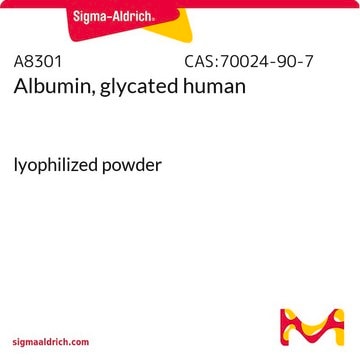The stability of this product in solution has not been evaluated. Generally, peptides should not be stored in solution for extended periods. Should solution storage be necessary, storing aliquots at -20°C is suggested. Note that peptides have a tendency to stick to plastic containers upon storage.
G9145
[Leu15]-Gastrin I human
≥95% (HPLC)
Sinonimo/i:
[Leu15]-HG-17, LHG-17, [15-Leucine]-Gastrin I, human heptadecapeptide, [18-Pyroglutamic acid, 32-leucine]-Big gastrin I-(18-34)-peptide amide, human, [Leu15]-Gastrin I, human, [Leucine15]-Gastrin I heptadecapeptide, [Leucine15]-Little gastrin I
Scegli un formato
Scegli un formato
About This Item
Prodotti consigliati
Origine biologica
human
Livello qualitativo
Saggio
≥95% (HPLC)
Stato
powder
tecniche
cell culture | mammalian: suitable
N° accesso UniProt
Temperatura di conservazione
−20°C
Stringa SMILE
CC(C)CC(NC(=O)C(Cc1c[nH]c2ccccc12)NC(=O)C3CCCN3C(=O)CNC(=O)C4CCC(=O)N4)C(=O)NC(CCC(O)=O)C(=O)NC(CCC(O)=O)C(=O)NC(CCC(O)=O)C(=O)NC(CCC(O)=O)C(=O)NC(CCC(O)=O)C(=O)NC(C)C(=O)NC(Cc5ccc(O)cc5)C(=O)NCC(=O)NC(Cc6c[nH]c7ccccc67)C(=O)NC(CC(C)C)C(=O)NC(CC(O)=O)C(=O)NC(Cc8ccccc8)C(N)=O
InChI
1S/C98H126N20O31/c1-49(2)38-68(115-96(147)72(43-55-46-101-60-19-12-10-17-58(55)60)117-98(149)74-20-13-37-118(74)77(122)48-103-86(137)61-25-31-75(120)105-61)93(144)111-66(30-36-82(131)132)92(143)110-65(29-35-81(129)130)91(142)109-64(28-34-80(127)128)90(141)108-63(27-33-79(125)126)89(140)107-62(26-32-78(123)124)88(139)104-51(5)85(136)113-70(41-53-21-23-56(119)24-22-53)87(138)102-47-76(121)106-71(42-54-45-100-59-18-11-9-16-57(54)59)95(146)114-69(39-50(3)4)94(145)116-73(44-83(133)134)97(148)112-67(84(99)135)40-52-14-7-6-8-15-52/h6-12,14-19,21-24,45-46,49-51,61-74,100-101,119H,13,20,25-44,47-48H2,1-5H3,(H2,99,135)(H,102,138)(H,103,137)(H,104,139)(H,105,120)(H,106,121)(H,107,140)(H,108,141)(H,109,142)(H,110,143)(H,111,144)(H,112,148)(H,113,136)(H,114,146)(H,115,147)(H,116,145)(H,117,149)(H,123,124)(H,125,126)(H,127,128)(H,129,130)(H,131,132)(H,133,134)
CMVMLPDUAGUTOC-UHFFFAOYSA-N
Informazioni sul gene
human ... GAST(2520)
Cerchi prodotti simili? Visita Guida al confronto tra prodotti
Amino Acid Sequence
Descrizione generale
Applicazioni
Azioni biochim/fisiol
Altre note
Codice della classe di stoccaggio
11 - Combustible Solids
Classe di pericolosità dell'acqua (WGK)
WGK 3
Punto d’infiammabilità (°F)
Not applicable
Punto d’infiammabilità (°C)
Not applicable
Dispositivi di protezione individuale
Eyeshields, Gloves, type N95 (US)
Scegli una delle versioni più recenti:
Certificati d'analisi (COA)
Non trovi la versione di tuo interesse?
Se hai bisogno di una versione specifica, puoi cercare il certificato tramite il numero di lotto.
Possiedi già questo prodotto?
I documenti relativi ai prodotti acquistati recentemente sono disponibili nell’Archivio dei documenti.
I clienti hanno visto anche
Articoli
Human pancreatic cancer organoid biobank (PDAC organoids) with various KRAS mutations to aide in 3D cell culture and cancer research applications.
-
After preparing aliquots, what is the stability of this product at -20?
1 risposta-
Utile?
-
-
Is this product also suitable for use with other mammalian species, such as mouse, for ex vivo tissue studies, as opposed to just human organoid culture medium?
1 risposta-
The product's validation for batch release does not currently cover murine ex vivo tissue testing. However, the following citations may provide insights into its application for ex vivo non-human samples:
Sci Adv. 2023 Nov 17;9(46):eadh0322. Title: Inactivation of the tumor suppressor gene Apc synergizes with H. pylori to induce DNA damage in murine gastric stem and progenitor cells PMID: 37967175
Infect Immun. 2016 Sep 19;84(10):3083-91. Title: Intestinal Enteroids Model Guanylate Cyclase C-Dependent Secretion Induced by Heat-Stable Enterotoxins PMID: 27481254
Utile?
-
-
I am interested in this product. A colleague uses it for human organoid culture medium. However, I work with murine ex vivo tissues. Is this also applicable for other mammalian species (so mouse in stead of human)?
1 risposta-
This product has not been tested for use with murine ex vivo tissue. However, the following citations may be of interest for its application in ex vivo non-human samples.
Sci Adv. 2023 Nov 17;9(46):eadh0322.
Inactivation of the tumor suppressor gene Apc synergizes with H. pylori to induce DNA damage in murine gastric stem and progenitor cells
PMID: 37967175
https://pubmed.ncbi.nlm.nih.gov/37967175/Infect Immun. 2016 Sep 19;84(10):3083-91.
Intestinal Enteroids Model Guanylate Cyclase C-Dependent Secretion Induced by Heat-Stable Enterotoxins
PMID: 27481254
https://pubmed.ncbi.nlm.nih.gov/27481254/Utile?
-
-
この製品の溶媒は何を用いればよろしいでしょうか。水またはPBS(-)には溶けますでしょうか、あるいはDMSOでしょうか。
1 risposta-
This product is tested for solubility at 1mg/ml in 0.1% NaOH or 1% NH4OH. Other solvents have not been evaluated.
Utile?
-
Filtri attivi
Il team dei nostri ricercatori vanta grande esperienza in tutte le aree della ricerca quali Life Science, scienza dei materiali, sintesi chimica, cromatografia, discipline analitiche, ecc..
Contatta l'Assistenza Tecnica.








![[Leu15,Gly18]-Gastrin2-17](/deepweb/assets/sigmaaldrich/product/images/384/185/d3095ca6-fe9a-4e1c-b2e9-29ad2bd40c46/640/d3095ca6-fe9a-4e1c-b2e9-29ad2bd40c46.jpg)
![[Gly18]-Gastrin 1-17 human](/deepweb/assets/sigmaaldrich/product/images/973/112/79e0734e-033a-4a31-9368-b08610cdcfd1/640/79e0734e-033a-4a31-9368-b08610cdcfd1.jpg)




